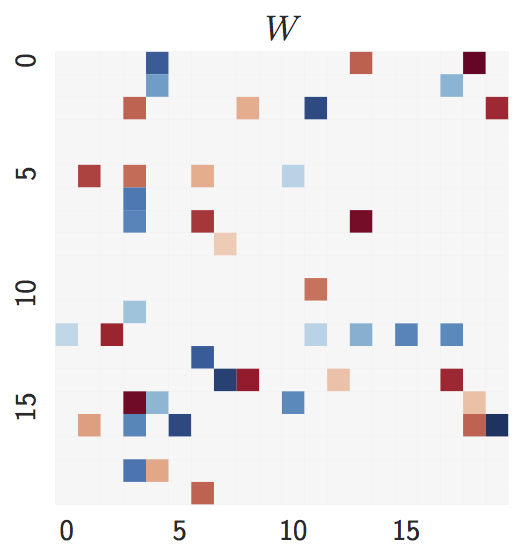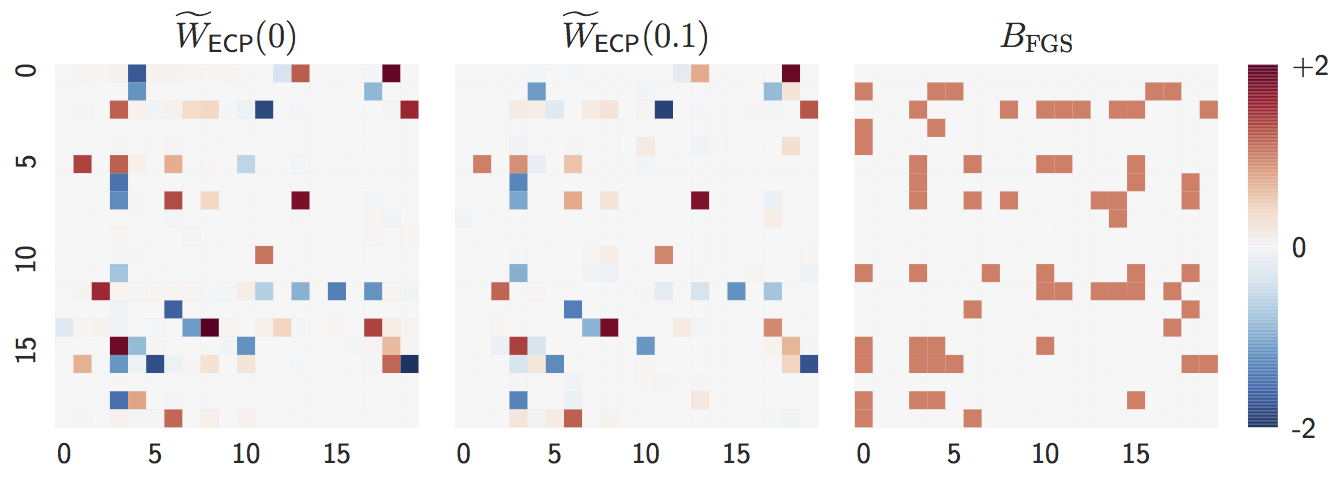[Update 12/8/22] Interested in faster and more accurate structure learning? See our new DAGMA library from NeurIPS 2022.
This is an implementation of the following papers:
[1] Zheng, X., Aragam, B., Ravikumar, P., & Xing, E. P. (2018). DAGs with NO TEARS: Continuous optimization for structure learning (NeurIPS 2018, Spotlight).
[2] Zheng, X., Dan, C., Aragam, B., Ravikumar, P., & Xing, E. P. (2020). Learning sparse nonparametric DAGs (AISTATS 2020, to appear).
If you find this code useful, please consider citing:
@inproceedings{zheng2018dags,
author = {Zheng, Xun and Aragam, Bryon and Ravikumar, Pradeep and Xing, Eric P.},
booktitle = {Advances in Neural Information Processing Systems},
title = {{DAGs with NO TEARS: Continuous Optimization for Structure Learning}},
year = {2018}
}
@inproceedings{zheng2020learning,
author = {Zheng, Xun and Dan, Chen and Aragam, Bryon and Ravikumar, Pradeep and Xing, Eric P.},
booktitle = {International Conference on Artificial Intelligence and Statistics},
title = {{Learning sparse nonparametric DAGs}},
year = {2020}
}
Check out linear.py for a complete, end-to-end implementation of the NOTEARS algorithm in fewer than 60 lines.
This includes L2, Logistic, and Poisson loss functions with L1 penalty.
Bayesian network, also known as reliability network, is an extension of Bayes method and is one of the most effective theoretical models in the field of uncertain knowledge representation and reasoning. Since it was proposed by Pearl in 1988, it has become a research hotspot in recent years. A Bayesian network is a directed acyclic graph consisting of nodes representing variables and directed edges connecting these nodes. Nodes represent random variables, and the directed edges between nodes represent the mutual relationship between nodes (from parent node to child node). Conditional probability is used to express the relationship strength, and prior probability is used to express information without parent node.
A directed acyclic graphical model with d nodes defines a
distribution of random vector of size d.
We are interested in the Bayesian Network Structure Learning (BNSL) problem:
given n samples from such distribution, how to estimate the graph G?
A major challenge of BNSL is enforcing the directed acyclic graph (DAG) constraint, which is combinatorial. While existing approaches rely on local heuristics, we introduce a fundamentally different strategy: we formulate it as a purely continuous optimization problem over real matrices that avoids this combinatorial constraint entirely. In other words,
where h is a smooth function whose level set exactly characterizes the
space of DAGs.
- Python 3.6+
numpyscipypython-igraph: Install igraph C core andpkg-configfirst.torch: Optional, only used for nonlinear model.
linear.py- the 60-line implementation of NOTEARS with l1 regularization for various lossesnonlinear.py- nonlinear NOTEARS using MLP or basis expansionlocally_connected.py- special layer structure used for MLPlbfgsb_scipy.py- wrapper for scipy's LBFGS-Butils.py- graph simulation, data simulation, and accuracy evaluation
The simplest way to try out NOTEARS is to run a simple example:
$ git clone https://github.com/xunzheng/notears.git
$ cd notears/
$ python notears/linear.pyThis runs the l1-regularized NOTEARS on a randomly generated 20-node Erdos-Renyi graph with 100 samples. Within a few seconds, you should see output like this:
{'fdr': 0.0, 'tpr': 1.0, 'fpr': 0.0, 'shd': 0, 'nnz': 20}
The data, ground truth graph, and the estimate will be stored in X.csv, W_true.csv, and W_est.csv.
Alternatively, if you have a CSV data file X.csv, you can install the package and run the algorithm as a command:
$ pip install git+git:https://github.com/xunzheng/notears
$ notears_linear X.csvThe output graph will be stored in W_est.csv.
-
Ground truth:
d = 20nodes,2d = 40expected edges.
-
Estimate with
n = 1000samples:lambda = 0,lambda = 0.1, andFGS(baseline).
Both
lambda = 0andlambda = 0.1are close to the ground truth graph whennis large. -
Estimate with
n = 20samples:lambda = 0,lambda = 0.1, andFGS(baseline).
When
nis small,lambda = 0perform worse whilelambda = 0.1remains accurate, showing the advantage of L1-regularization.
-
Ground truth:
d = 20nodes,4d = 80expected edges.
The degree distribution is significantly different from the Erdos-Renyi graph. One nice property of our method is that it is agnostic about the graph structure.
-
Estimate with
n = 1000samples:lambda = 0,lambda = 0.1, andFGS(baseline).
The observation is similar to Erdos-Renyi graph: both
lambda = 0andlambda = 0.1accurately estimates the ground truth whennis large. -
Estimate with
n = 20samples:lambda = 0,lambda = 0.1, andFGS(baseline).
Similarly,
lambda = 0suffers from smallnwhilelambda = 0.1remains accurate, showing the advantage of L1-regularization.
- Python: https://github.com/jmoss20/notears
- Tensorflow with Python: https://github.com/ignavier/notears-tensorflow
